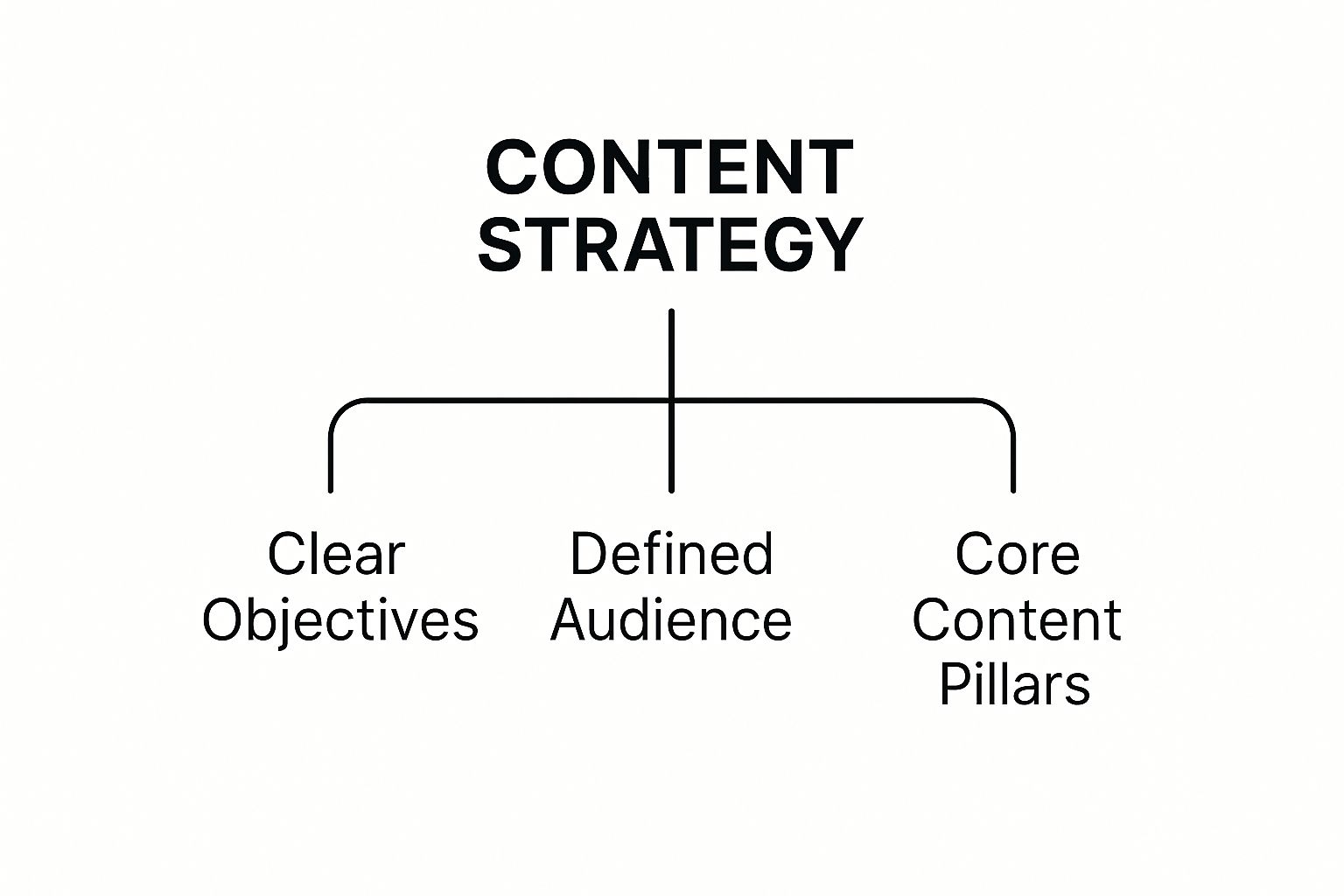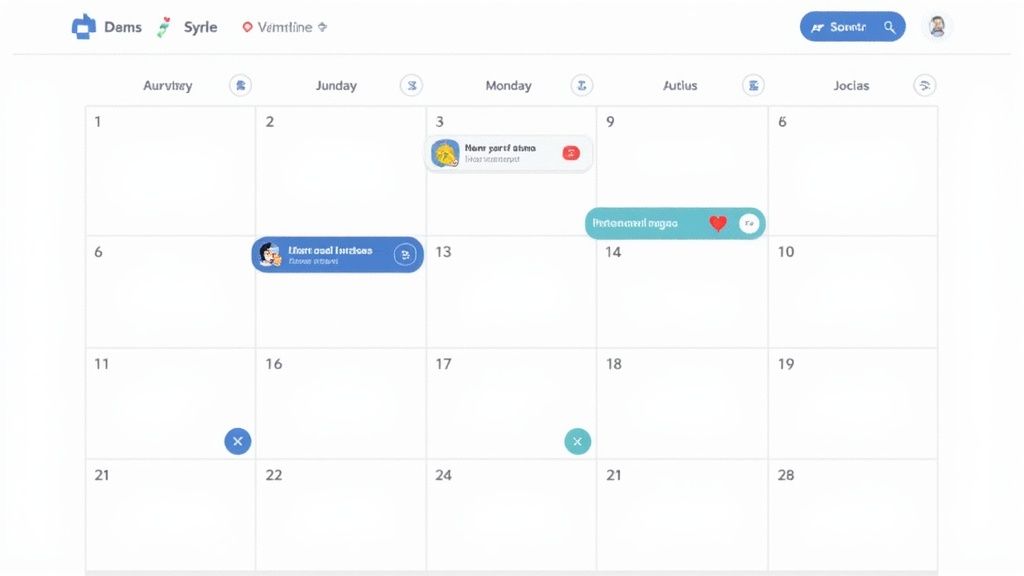Master Your Content Strategy for Social Media in 2024

Think of your social media content strategy as the master blueprint for everything you create and share online. It’s what turns random, sporadic posts into a reliable system for building a community and, ultimately, driving business results. It’s the connective tissue between your big-picture goals and every single tweet, story, and video you publish.
Why Your Social Media Needs a Real Strategy
Posting on social media without a strategy is a bit like being a master chef who just throws random ingredients into a pan, hoping for the best. Sure, you might get lucky once in a while and create something decent, but you'll never be able to repeat that success consistently. A social media content strategy is your recipe—it provides the structure, purpose, and direction you need to cook up something remarkable every single time. It transforms chaotic effort into a predictable process.
This plan is far more than a simple posting schedule. It’s a comprehensive roadmap that dictates why you're posting, who you're talking to, what you'll say, and how you'll know if any of it is actually working. It’s the framework that ensures every piece of content serves a distinct purpose, inching you closer to your business objectives.
The Foundation of Strategic Content
At its core, a successful strategy is built on a few non-negotiable foundations. When these elements work together, they create a cohesive and effective presence that’s strong enough to cut through all the online noise.
This infographic breaks down those essential components.

As you can see, a central strategy has to branch out into specific, well-defined areas—your objectives, your audience, and your core content pillars—to have any real impact.
Without this structure, your efforts will feel disjointed and random. But with it, you create a powerful system that guides every decision you make. For a deeper dive into building one from the ground up, this ultimate social media content strategy guide covers everything from planning to measuring performance.
To truly understand how these pieces fit together, it helps to think of them as the four pillars holding up your entire social media presence.
The Four Pillars of Social Media Content Strategy
| Pillar | Description | Key Question to Answer |
|---|---|---|
| Business Goals | The "why" behind your social media efforts. These are tangible business objectives, not just vanity metrics. | What do we want to achieve? (e.g., increase leads, drive website traffic, boost brand awareness) |
| Target Audience | A deep understanding of who you are trying to reach, including their pain points, interests, and online behaviors. | Who are we talking to? |
| Content Pillars | The 3-5 core themes or topics your brand will consistently talk about. These pillars align your content with your expertise and your audience's interests. | What will we talk about? |
| Platform Selection | Choosing the right social networks where your target audience is most active and engaged. | Where will we share our content? |
Each pillar supports the others, creating a stable and powerful foundation. If one is weak, the whole structure can wobble.
Navigating a Crowded Digital World
Having a sharp strategy is more critical today than ever before. In 2025, there are an estimated 5.42 billion social media users worldwide. On top of that, the average person uses 6.83 different social networks each month. This points to a massive, yet incredibly fragmented, audience. A one-size-fits-all approach is simply doomed to fail.
This reality means your strategy must account for the unique culture and user behavior of each platform, whether it’s Instagram, TikTok, or LinkedIn. With 93% of marketers planning to ramp up their social media efforts, the competition for attention is only getting more intense. A documented, thoughtful strategy is your best advantage to stand out and build genuine connections in all that chaos.
Define Your Goals and Understand Your Audience
 Every powerful content strategy for social media boils down to two simple questions: Why are we doing this, and who are we talking to? Get these wrong, and your content is like a ship without a rudder—drifting aimlessly with no real destination in sight.
Every powerful content strategy for social media boils down to two simple questions: Why are we doing this, and who are we talking to? Get these wrong, and your content is like a ship without a rudder—drifting aimlessly with no real destination in sight.
Before you write a single post, you need to turn vague hopes into concrete, measurable objectives. Just "posting for the sake of posting" is a fast track to burning resources with nothing to show for it. Instead, every bit of your social media activity has to be tied directly to real business outcomes. This means ditching generic goals like "increase engagement" and getting much more specific.
Set Powerful SMART Goals
The SMART framework isn't just a business school acronym; it's a vital tool for giving your strategy a spine. It forces you to get crystal clear on what you’re trying to accomplish, making sure your goals are trackable and actually serve your bigger business mission.
Each goal should be:
- Specific: Nail down exactly what you want to achieve. Don't just say "more followers." Aim for "gain 500 new followers on LinkedIn."
- Measurable: How will you track progress? "Increase website traffic" becomes "achieve a 20% increase in website clicks from Instagram Stories."
- Achievable: Be ambitious, but realistic. If you just launched your account, aiming for a million followers in a month is a setup for failure. Base your goals on your resources and benchmarks.
- Relevant: Does this goal actually matter to the business? Make sure it supports key objectives like generating leads or improving customer retention.
- Time-bound: Give yourself a deadline. It creates urgency and a clear point for evaluation. For example, "by the end of Q2."
A truly solid SMART goal sounds like this: "To support our new product launch, we will generate 50 qualified leads through our LinkedIn content campaign by the end of this quarter." Now that’s an objective. It's specific, measurable, and directly tied to a business result, giving you a clear benchmark for success.
Go Beyond Demographics to Understand Your Audience
Once you know your why, you have to figure out your who. A surface-level understanding of your audience will lead to content that falls flat. Demographics like age, gender, and location are a decent starting point, but they don't tell you what makes people tick.
To build a truly effective social media strategy, you have to dig into psychographics—the motivations, struggles, values, and online behaviors of your ideal customer. The aim is to build an audience persona so vivid it feels like a real person you're having a conversation with.
The goal is to understand your audience so well that you can create content that makes them feel seen, heard, and understood. This is where real connection—and loyalty—is born.
You don't need a massive research budget to uncover these deeper insights. You can find gold by mining information that's already at your fingertips.
- Analyze Your Social Analytics: Tools like Facebook Insights and Instagram Insights show you what content formats your current followers love and when they’re most active.
- Read Customer Reviews: Go through reviews for your products and your competitors'. What words do people use? What problems are they trying to solve?
- Monitor Competitor Comments: The comment sections on your competitors' top posts are a goldmine. What questions are people asking? What are they praising? You'll find a treasure trove of your audience's pain points and desires.
- Conduct Simple Surveys: Use Instagram Stories polls or a quick survey to ask your audience directly what they care about and what they're struggling with.
By blending basic demographic data with these richer psychographic insights, you can create a detailed persona. Give them a name, a job, and a backstory. Write down their goals, their frustrations, and where they hang out online. This detailed portrait becomes your North Star, guiding every piece of content you create and making sure it always hits the mark.
Right, so you've got your goals locked in and a crystal-clear picture of who you're talking to. Now comes the fun part: figuring out where you'll show up and what you'll actually talk about.
Trying to be on every single social media platform is a surefire way to burn out fast and see your efforts fall flat. The real key here is strategic focus.
Think about it—not all social platforms are the same. Each has its own vibe, its own rules of engagement, and its own audience expectations. The goal is to find that sweet spot where your target audience hangs out and where your brand's personality can truly shine. This keeps you from shouting into the void on a network where your ideal customer isn't even listening.
Select Your Core Social Media Platforms
Choosing your platforms is like picking the right venue for an event. You wouldn't throw a high-end corporate gala in a dive bar, and you wouldn't host a punk rock show in a library. The place has to fit the people and the purpose.
It's not just a hunch, either. Research from Econsultancy shows that a whopping 67% of marketers see a better return when they create a unique strategy for each platform. This proves that a one-size-fits-all approach just doesn't cut it. You can't just spray the same content everywhere and hope for the best.
Here's a quick cheat sheet to get you started:
- For B2B brands and professional services: Your home base is LinkedIn. It’s tailor-made for industry deep-dives, professional networking, and cementing your status as a thought leader.
- For highly visual brands (think fashion, food, travel): You absolutely need to be on Instagram and Pinterest. These platforms are all about stunning aesthetics, inspiration, and telling stories through images and video.
- For brands targeting Gen Z and younger millennials: TikTok is a non-negotiable. Its algorithm is a beast that rewards entertaining, trend-driven, short-form video.
- For broad community building and local reach: Facebook is still a titan. It's incredibly versatile for building communities and connecting with a huge range of demographics.
Remember, the goal isn't to be everywhere. It's to be excellent on the two or three platforms that will actually move the needle for your business.
Develop Your Core Content Pillars
Okay, you've picked your channels. Now, what are you going to post? This is where content pillars come in.
Think of them as the main sections of your favorite magazine or the go-to genres on a TV network. They are the 3-5 core themes you'll consistently create content around. This gives your entire social media presence a solid foundation and a clear direction.
Content pillars are the backbone of your strategy. They make sure every post feels like it's coming from you, speaks directly to your audience, and supports your bigger business goals. Best of all, they kill the "what do I post today?" paralysis. Instead of staring at a blank calendar, you just ask, "Which pillar are we hitting today?"
Content pillars are what turn a random stream of posts into a cohesive, valuable experience for your followers. They give people a reason to follow you and stick around, because they know exactly what kind of awesome stuff to expect.
To build yours, just brainstorm where your expertise overlaps with what your audience is genuinely interested in (and struggling with).
Example Content Pillars for a Financial Advisor:
- Jargon-Free Lessons: Break down tricky financial concepts like retirement funds, investing, or tax tips into bite-sized, easy-to-digest posts.
- Market Pulse: Share timely takes on what's happening in the market and, more importantly, what it means for the average person.
- Real-World Wins (Anonymized): Tell stories of how smart financial planning helped real people solve real problems. Nothing builds trust like results.
- Myth-Busting Mondays: Tackle common money myths head-on to establish authority and clear up confusion.
- Behind the Brand: Show the human side of the business. Introduce the team, share the company's values, or give a peek into a day in the life.
This mix of pillars keeps the content balanced. It educates, entertains, and builds trust without constantly screaming "buy my stuff!" By setting these themes, you create a reliable system that makes content creation a breeze and turns casual scrollers into a community of loyal fans.
Of course. Here is the rewritten section, following all of your specific instructions and style guidelines.
Master Modern Content Creation and Curation

Alright, you've set your goals, figured out who you're talking to, and established your content pillars. Now for the fun part: deciding what you're actually going to post. These days, creating great content is a blend of genuine human creativity and some really smart tech. It’s no longer about one person grinding it out alone; it's about using the right tools to get your authentic voice heard.
Think of AI as your new strategic partner. Its job isn't to take over and sound like a robot, but to handle some of the heavy lifting. AI tools can be incredible for brainstorming, knocking out a first draft, or spotting new content angles based on what's trending. This frees you up to focus on what you do best: building a real community.
This partnership is all about scaling your content without losing your soul. You bring the empathy, the big-picture strategy, and the unique spark that makes your brand yours. The AI just helps you get it done faster and more efficiently, turning that scary blank page into a field of solid ideas.
The Rise of AI in Social Media Strategy
AI isn't some far-off concept anymore; it's a daily tool for marketers everywhere. In fact, AI-generated content has become a major player in social media. A staggering 80% of marketers are using AI in their digital marketing, with 71% specifically using it for creating and optimizing their social media content. This isn't just a trend—it's a reflection of how AI delivers both efficiency and creativity. To keep up, you have to be willing to experiment with what AI can do.
If you want to get into the nitty-gritty, our guide on social media content creation breaks down exactly how to fold these methods into your routine.
The Art of Content Curation
Here’s a secret: not everything you post has to be something you made from scratch. One of the smartest moves you can make is content curation—the simple act of finding and sharing great content from other credible sources in your field.
Think of it like being a great host at a party. You wouldn't spend the whole night just talking about yourself, right? You’d introduce people, bring up interesting articles you've read, and get conversations going. That's exactly what content curation is, but for your social feed.
Curation shows you care more about giving your audience value than just pushing your own stuff. It transforms your brand from just a seller into a helpful, trusted hub of industry knowledge.
This simple shift in mindset unlocks some serious benefits:
- Builds Industry Goodwill: When you share content from other experts, you build bridges and show you’re a team player.
- Fills Your Content Calendar: Let's be real, some days the well of original ideas runs dry. Curation is the perfect way to keep your feed active and valuable.
- Adds Credibility: Sharing content from respected sources reinforces your own expertise. It proves you have your finger on the pulse of what's happening in your industry.
How to Curate Content Effectively
Good curation is more than just blindly hitting the "share" button. It's a thoughtful process to make sure what you share is actually useful for your audience and fits your brand.
Find Relevant Sources: Make a list of the top blogs, publications, thought leaders, and even complementary brands in your space. Tools like Feedly or even a private Twitter list are great for keeping tabs on them.
Vet for Quality and Alignment: Before you share anything, do a quick gut check. Is this accurate? Is the source trustworthy? Does it align with my brand’s values and what my audience cares about?
Add Your Own Perspective: This is the most important step. Never just share a link. Tell your audience why it's worth their time. Pull out a key quote and ask for their take, or add your own two cents. This simple act turns a passive share into an active conversation.
By balancing your own original posts with thoughtfully curated content, you create a much richer and more dynamic feed. This blended approach keeps your audience hooked and solidifies your status as the go-to resource in your niche. And if you're looking for more ways to keep things fresh, exploring different social media content ideas to boost engagement is a fantastic next step.
Plan and Distribute Your Social Media Content
A brilliant strategy is just a nice idea if it's stuck in your head or a forgotten file. This is where the rubber meets the road. Disciplined planning and smart distribution are what separate a good social media content strategy from a great one that actually moves the needle.
Think of it this way: your content pillars are your core ingredients, and your content calendar is the detailed recipe telling you exactly when and how to combine them. This isn't about boxing yourself in; it’s about creating a system that frees you from the daily panic of "what on earth do I post today?" and helps you deliver quality, consistently.
Create a Functional Content Calendar
Your content calendar is your single source of truth for getting things done. It’s the tool you use to turn your big strategic themes into actual posts scheduled for specific days and times. Honestly, even a simple spreadsheet can work wonders, but dedicated tools can save you a ton of time.
For each piece of content, your calendar should map out a few key details:
- Post Date and Time: Pinpoint exactly when the post goes live, ideally timed for when your audience is scrolling the most.
- Platform: Clearly mark if the post is for Instagram, LinkedIn, TikTok, or somewhere else.
- Content Pillar: Tag each post with one of your pillars. This is a gut check to make sure you have a balanced mix of content.
- Copy and Visuals: Drop in the exact text, hashtags, and a link to the finished image, video, or graphic.
- Call-to-Action (CTA): What do you want people to do? Spell it out, whether it’s "Shop Now," "Learn More," or "Share your thoughts."
A well-structured content calendar doesn't just organize your posts; it operationalizes your strategy. It’s the bridge between your high-level goals and the daily actions required to achieve them.
Using scheduling tools like Buffer or Hootsuite can put the actual publishing on autopilot, saving you a massive amount of time and making sure you never miss a prime posting window. For a much deeper dive into building this foundational tool, our guide on content planning for social media gives you a complete step-by-step framework.
Maximize Reach Through Smart Distribution
Creating fantastic content is only half the job. Getting people to actually see it is the other half. Your distribution plan is what makes sure all your hard work doesn't just get lost in the noise. This usually involves a mix of organic (free) tactics and, when the time is right, a little paid amplification.
First, squeeze every drop of value out of your organic reach. This is all about the free visibility you earn through smart, non-paid efforts.
- Strategic Hashtags: Don't just throw random tags on a post. Use a mix of broad, niche, and branded hashtags to help new people discover your content.
- Community Engagement: Never just post and ghost. Jump into the comments and messages. Responding to people fuels conversations and tells the platform's algorithm that your content is interesting.
- Cross-Platform Promotion: Just posted a new Reel on Instagram? Mention it in your Stories. Shared a big article on LinkedIn? Tweet about it. Guide the followers you already have to your newest content.
Next, you need to spot your winners. After a week or so, peek at your analytics. See which posts are getting the most love. Is there a video with way more views or an educational carousel with tons of saves? That’s your prime candidate for a small paid boost. By putting a bit of budget behind content that has already proven itself organically, you’re not just guessing—you’re amplifying what works to reach a much wider, targeted audience.
Measure Performance and Optimize Your Strategy
https://www.youtube.com/embed/LJewZGw7X7I
A social media content strategy isn't a "set it and forget it" document you create once and then file away. Think of it as a living, breathing plan that needs to adapt to what's happening in the real world. To do that, you need to close the loop with data, turning numbers into insights that actually help you improve.
This means you have to look past the flashy vanity metrics. Instead, focus on the key performance indicators (KPIs) that directly tie back to the goals you set earlier. Without measurement, you’re just guessing. With it, you get the clarity to stop doing what isn’t working and go all-in on what your audience truly loves.
Matching Metrics to Your Social Media Goals
So, you've got a pile of data from your social media analytics. What now? The first step is to stop treating all that data as equal. The metrics that actually matter depend entirely on what you're trying to achieve. A post designed to get your brand name out there has a totally different definition of success than one created to drive traffic to your website.
Think of it like this: if you don't know the score, you don't know if you're winning. By aligning your KPIs with your main objectives, you create a clear scoreboard for your efforts. This ensures you're measuring real progress and not getting sidetracked by numbers that don't mean much for your business.
This targeted approach helps you understand the story behind your performance. For a deeper dive into which numbers to watch, check out our complete guide on the most important social media metrics to track for your business.
Measuring performance isn't about collecting data; it's about understanding what that data is telling you. It’s the feedback loop that makes your strategy smarter over time.
Conduct Regular Performance Reviews
To make your data truly useful, you need a routine for reviewing it. Setting aside time monthly or quarterly is the perfect rhythm to analyze performance without getting lost in the weeds of daily ups and downs. This process helps you spot trends, pinpoint your star content, and make decisions based on facts, not feelings.
During your review, ask yourself these crucial questions:
- What content did people love most? Look at posts with the highest engagement—likes, comments, shares, and saves. What topics, formats, or tones drove that interaction?
- Which formats are winning? Are your Reels getting more reach than static posts? Are carousels outperforming single images? The data will tell you.
- Which platforms are pulling their weight? Where is the most valuable traffic or the best leads coming from?
- What was the overall vibe? Were the comments and mentions positive, negative, or just neutral?
When looking at your reach, it's also smart to be aware of things like potential shadow banning on social media, which can quietly hurt your visibility.
The answers you find are your roadmap for what to do next. They tell you exactly where to invest your time and resources, ensuring your content strategy gets more effective and efficient with every cycle.
Frequently Asked Questions

You've got questions, and that's a good thing. It means you're taking this seriously. Let's tackle some of the most common hurdles people face when building a social media content strategy so you can move forward with total confidence.
How Often Should I Post on Social Media?
Honestly, there’s no magic number that works for everyone. The right posting frequency really boils down to the platform you're on and what your specific audience has come to expect from you.
On a fast-moving platform like X (formerly Twitter), you might find success posting several times a day. For something like Instagram, a good starting point is often 3-5 times per week.
The real secret? Consistency over quantity. It's far better to share three genuinely valuable, high-quality posts a week than to push out seven that are just okay. Dive into your analytics to see when your audience is online, and don't be afraid to experiment with your schedule to see what gets the best reaction.
What Is the Difference Between a Content Strategy and a Content Calendar?
Let's use a simple analogy: building a house.
Your social media content strategy is the architect's blueprint. It lays out the big picture: your goals (the why), your audience (the who), and your core content themes (the overall style and feel of the house).
Your content calendar is the construction schedule. It gets into the nitty-gritty, mapping out which specific posts go live on which days, what photos or videos are needed, and who is responsible for what. It's the tool that keeps the project moving forward on time.
Your strategy is the "why" and "what," while your calendar is the "when" and "how." One provides direction; the other provides discipline.
How Long Does It Take to See Results?
This is the hard part: you have to be patient. While you might see some encouraging bumps in likes and comments within the first few weeks, seeing a real impact on your business goals—like generating leads or driving sales—usually takes about 3-6 months of consistent, focused effort.
Remember, you're building a community and earning trust, and that simply doesn't happen overnight. Keep a close eye on leading indicators like your engagement rate and website clicks. These early metrics are your proof that the strategy is working, long before the major business results start rolling in.
Ready to turn your best content into stunning, high-engagement carousels? Lumeo uses AI to transform articles, videos, and even tweets into visual assets perfect for LinkedIn and Instagram. Start creating for free and watch your online visibility grow. Discover how at https://lumeo.me.